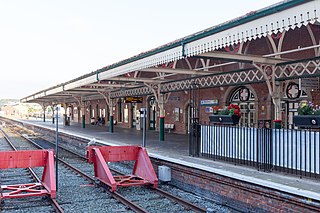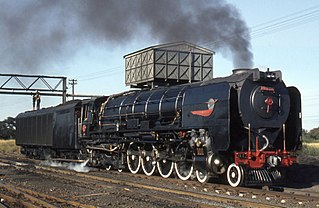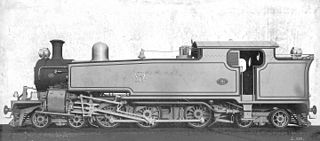
A steam locomotive is a locomotive that provides the force to move itself and other vehicles by means of the expansion of steam. It is fuelled by burning combustible material to heat water in the locomotive's boiler to the point where it becomes gaseous and its volume increases 1,700 times. Functionally, it is a steam engine on wheels.

The vacuum brake is a braking system employed on trains and introduced in the mid-1860s. A variant, the automatic vacuum brake system, became almost universal in British train equipment and in countries influenced by British practice. Vacuum brakes also enjoyed a brief period of adoption in the United States, primarily on narrow-gauge railroads. Their limitations caused them to be progressively superseded by compressed air systems starting in the United Kingdom from the 1970s onward. The vacuum brake system is now obsolete; it is not in large-scale usage anywhere in the world, other than in South Africa, largely supplanted by air brakes.

A tender or coal-car is a special rail vehicle hauled by a steam locomotive containing its fuel and water. Steam locomotives consume large quantities of water compared to the quantity of fuel, so their tenders are necessary to keep them running over long distances. A locomotive that pulls a tender is called a tender locomotive. Locomotives that do not have tenders and carry all their fuel and water on board the locomotive itself are called tank locomotives or tank engines.
Brush Traction was a manufacturer and maintainer of railway locomotives in Loughborough, England whose operations have now been merged into the Wabtec company's Doncaster UK operations.

The Cambrian Railways owned 230 miles (370 km) of track over a large area of mid Wales. The system was an amalgamation of a number of railways that were incorporated in 1864, 1865 and 1904. The Cambrian connected with two larger railways with connections to the northwest of England via the London and North Western Railway, and the Great Western Railway for connections between London and Wales. The Cambrian Railways amalgamated with the Great Western Railway on 1 January 1922 as a result of the Railways Act 1921. The name is continued today in the route known as the Cambrian Line.

The Vale of Rheidol Railway is a 1 ft 11+3⁄4 in narrow gauge heritage railway in Ceredigion, Wales, between Aberystwyth and Devil's Bridge; a journey of 11+3⁄4 miles (18.9 km).

The British Rail Class 76, also known as Class EM1, is a class of 1.5 kV DC, Bo+Bo electric locomotive designed for use on the now-closed Woodhead Line in Northern England.

Aberystwyth railway station is located in the town of Aberystwyth, Ceredigion, Wales; it is served by passenger trains operated by Transport for Wales. It is the terminus of both the Cambrian Line and of the narrow-gauge Vale of Rheidol Railway.
Dick, Kerr and Company was a locomotive and tramcar manufacturer based in Kilmarnock, Scotland and Preston, England.

Joy valve gear is a type of steam locomotive valve gear, designed by David Joy, Locomotive and Marine engineer, and patented on 8 March 1879. The British patent has not been found but the US patent has. Joy's gear is similar to Hackworth valve gear but has a compensating mechanism which corrects for "the slight inequality in the motion of the valve arising from the arc of the lever".

Thomas Green & Son, Ltd. were engineers who manufactured a wide range of products at the Smithfield Foundry, Leeds, United Kingdom
The Manchester and Milford Railway was a Welsh railway company, intended to connect Manchester and the industrial areas of North West England with a deep-water port on Milford Haven, giving an alternative to the Port of Liverpool.

The Phyllis Rampton Narrow Gauge Railway Trust is a British charity which is registered with the British Charity Commission as 292240 under the classification of "Education/Training Environment/Conservation/Heritage". The Trust is the 100% shareholder of the Vale of Rheidol Railway in Wales and was established to both protect the future of the railway and provide funds to build a museum at Aberystwyth station.

The South African Railways Class 25 4-8-4 of 1953 was a condensing steam locomotive.

The South African Railways Class K 4-6-4T of 1917 was a steam locomotive.

Heenan & Froude was a United Kingdom-based engineering company, founded in Newton Heath, Manchester, England in 1881 in a partnership formed by engineers Richard Froude and Richard Hammersley Heenan. Expanded on the back of William Froude's patent for inventing the water brake dynamometer, their most famous creation was the 518 feet (158 m) high Blackpool Tower.

Crown Metal Products was a manufacturer of railroad rolling stock based in Wyano, Pennsylvania. The company was founded by Ken Williams in 1946 and initially sold pot cleaners and then electric fence wires and other products. In 1959, the company began to transition into producing narrow gauge locomotives, a personal interest of Williams. The company went on to produce steam locomotives and passenger cars of various sizes for amusement park railroads. The firm ceased production in 1989; however, much of its rolling stock continues to operate at various locations around the world.

The GWR Rheidol Tanks are a fleet of 2-6-2T steam locomotives of the Great Western Railway design built between 1923 and 1924. They were designed by the railway's Chief Mechanical Engineer, Charles Collett, for working services on the Vale of Rheidol Railway between Aberystwyth and Devil's Bridge (Pontarfynach).

Rheidol, formerly named Treze de Maio and Talybont, was a 2-4-0T steam locomotive built by W.G. Bagnall in Staffordshire, England, in 1896. Originally built to a gauge of 2 ft 5+1⁄2 in, it was for a Brazilian sugar plantation, however the order was cancelled before it was exported. The locomotive was then regauged and renamed for the 2 ft 3 in -gauge Plynlimon and Hafan Tramway, in Wales, where it worked from August 1897 until 1899. It was then regauged and renamed a second time for 1 ft 11+3⁄4 in -gauge Vale of Rheidol Railway, in 1900. It worked on the Vale of Rheidol until 1924, when it was scrapped.
















